Last updated on 6 May, 2023
800 million years in the making and one of Australia’s most iconic destinations, the Flinders Ranges is dog friendly. Meander with us through ancient landscapes and rugged mountains carved out of the red earth and explore the Flinders Ranges with your dog.
Learn about the Aboriginal cultures of the Adnyamathanha and Ngadjuri people and the lives of those who settled the sun-baked mountains and outback.
Grab your dog, your camping supplies, your dog’s camping gear, camera and sense of adventure. Scenic drives, towering gorges, geological marvels, 4WD tracks, hikes and more await you and your dog in the Flinders Ranges, South Australia.
Disclosure: This post may contain affiliate links. If you use these to make a purchase, I may earn a commission. Any commission is greatly appreciated as it helps to keep Our Wayfaring Life online.
- General Information for a Flinders Ranges Road Trip
- Can I take my dog to the Flinders Ranges?
- Flinders Ranges Tours From Adelaide | Dog Sitting Available
- Getting to the Flinders Ranges | Driving Distances
- Do you need a 4WD for the Flinders Ranges?
- I am Towing, are the Flinders Ranges Very Hilly and Winding?
- Should the Flinders Ranges be included in a Lap of Australia?
- How Long Do You Need to Visit the Flinders Ranges?
- When is the Best Time to Visit the Flinders Ranges?
- How Much to Budget for a Flinders Ranges Exploration?
- Where Can You Buy Fuel in the Flinders Ranges?
- Stock Up Food Supplies
- Mobile Phone Reception
- What Wildlife and Birdlife are there in the Ranges?
- Travel the Flinders Ranges with your Dog | A Road Trip Itinerary
- Where To Next?
- PIN It!
- Recent Posts
General Information for a Flinders Ranges Road Trip
Can I take my dog to the Flinders Ranges?
The Flinders Ranges is dog friendly. Other than the national parks that covers only some of the ranges 41000 square kilometres and a handful of attractions, we found dogs are welcome. Camp, hike and sightsee with your dog, together you will have a brilliant experience!
In this guide, all caravan parks and campgrounds are dog friendly. So are the attractions unless otherwise stated. You may be surprised just how much there is to do with your dog in the Flinders Ranges.
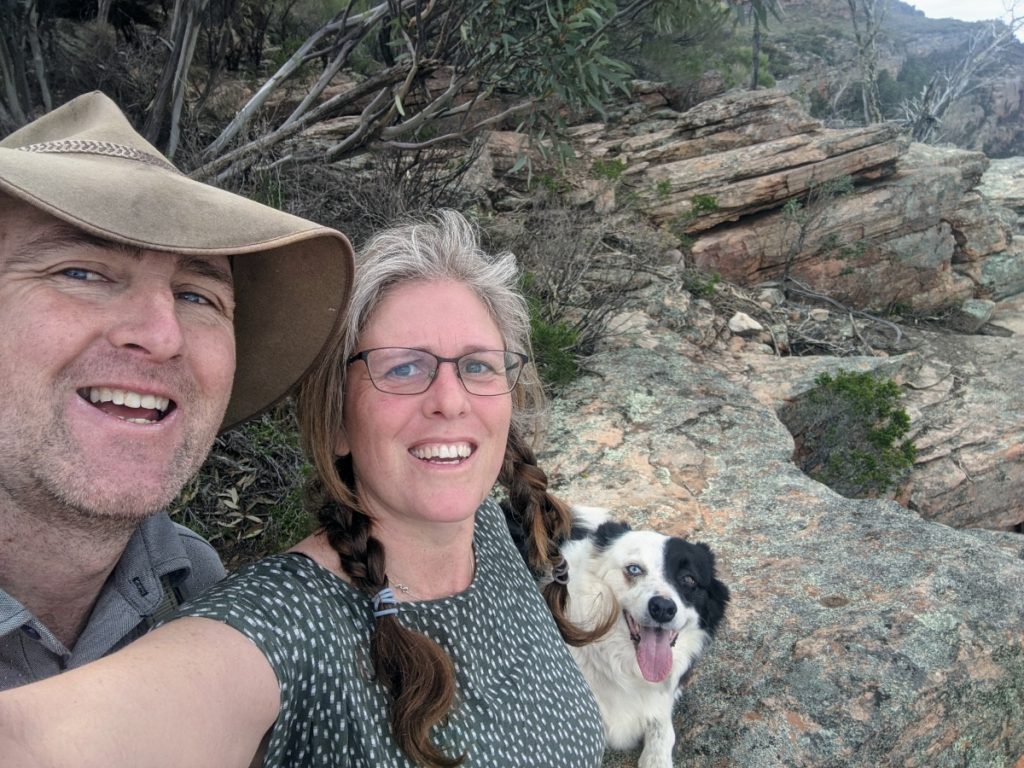
Daryl and I are dog owners that will include our dog Chika in as many things we do as possible. That said, we are also owners that will do some activities that are not dog friendly. For this reason, I have included a few select attractions your dog will have to sit out. It is entirely up to you if you choose to do these or not.
Flinders Ranges Tours From Adelaide | Dog Sitting Available
The Flinders Ranges is a top region to see with your dog. There will be some dogs this road trip may not suit, perhaps because your dog:
- is elderly or has poor mobility; or
- cannot be left alone for you to visit the national park.
That is okay. An alternative as a dog owner to see the Flinders Ranges is have your dog cared for and pampered by a pet sitter in Adelaide. Then either venture out on a self drive tour of the ranges using our guide or alternatively go on a Flinders Ranges guided tour.
Getting to the Flinders Ranges | Driving Distances
From the south:
- Port Augusta to Quorn | 39 kilometres or 30 minutes
- Adelaide to Quorn | 337 kilometres or 3 hours 45 minutes
- Melbourne to Quorn | 1070 kilometres or 11 hours 30 minutes
From the north:
- Coober Pedy to Marree via William Creek Road and The Oodnadatta Track | 370 kilometres or 4 hours 35 minutes
- Birdsville to Marree via The Birdsville Track | 519 kilometres or 9 hours 10 minutes
- Alice Springs to Marree via The Oodnadatta Track | 1056 kilometres or
Do you need a 4WD for the Flinders Ranges?
The answer is no but..
The Flinders Ranges is accessible by 2WD thanks to the Outback Highway from Quorn to Marree and the Flinders Ranges Way from Hawker to Blinman. Both roads are bitumen, running along the west and east sides of the Ikara-Flinders Ranges National Park. Parachilna Gorge Road links these two roads and although it is dirt, it is suitable for 2WD vehicles.
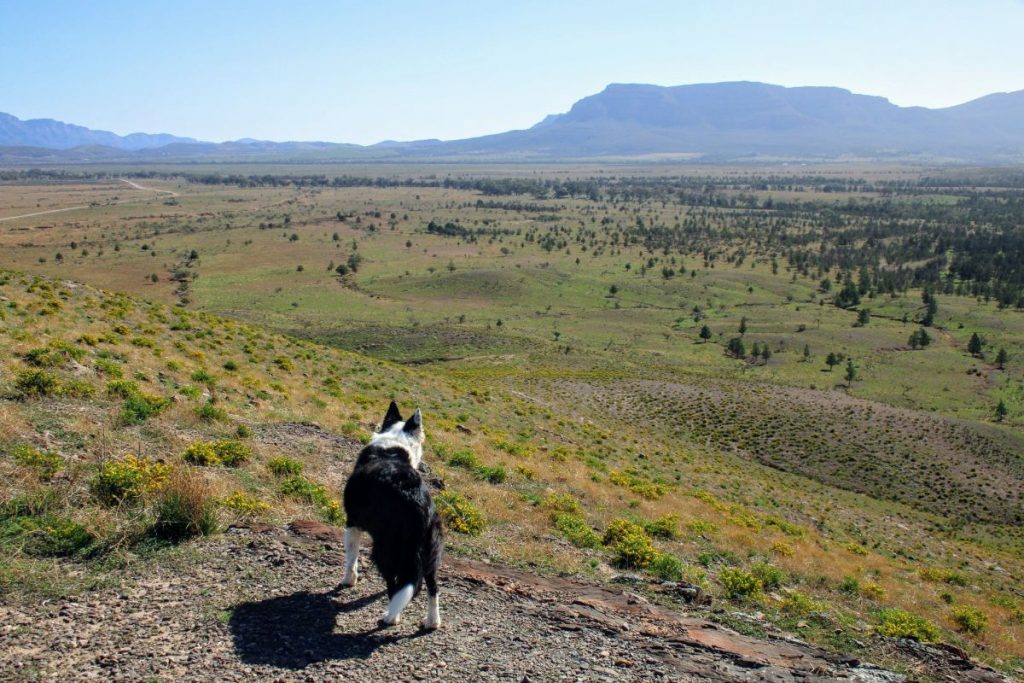
So why the “but”? Well, because the N Flinders Road between Blinman and Arkaroola and the Gammon Ranges Road between Copley and Arkaroola are both dirt roads with changing conditions best suited to 4WD vehicles. There are also tourist drives out to gorges and other sites along roads only suitable for 4WD vehicles.
The answer to the question if you need a 4WD comes down to:
- What vehicle you have access to – if you only have access to a 2WD then do not let that stop you from visiting the Flinders Ranges. There is still plenty for you to see and do as well as places to stay.
- If you want to get out to the more remote areas and see as much as possible – then bring a 4WD!
The best place to find out the conditions of the roads visit the South Australia Outback Roads or if you are heading out to Arkaroola, contact the Arkaroola Wilderness Sanctuary. We found asking a local in Blinman was helpful and you could also ask at Copley or Leigh Creek.
I am Towing, are the Flinders Ranges Very Hilly and Winding?
Having traveled through and over many mountain ranges on our travels, I can say with absolute certainty that the roads in the Flinders Ranges are not winding or very hilly.
Should the Flinders Ranges be included in a Lap of Australia?
Yes!
One of Australia’s most unique landscapes and regions, visiting the Flinders Ranges is remarkable and will leave a lasting impression. Only 40 kilometres from the National 1 Highway at Port Augusta to Quorn and with sealed roads to Blinman and Marree, it is incredibly accessible.
How Long Do You Need to Visit the Flinders Ranges?
How much time to allow depends on how much of the Flinders Ranges you would like to see. Here is what I would recommend as a minimum depending on which route you choose to take:

Route 1 (2WD option) | Quorn to Hawker, Hawker to Blinman, Blinman to Parachilna, Parachilna back to Hawker and Quorn loop | 2 – 5 days
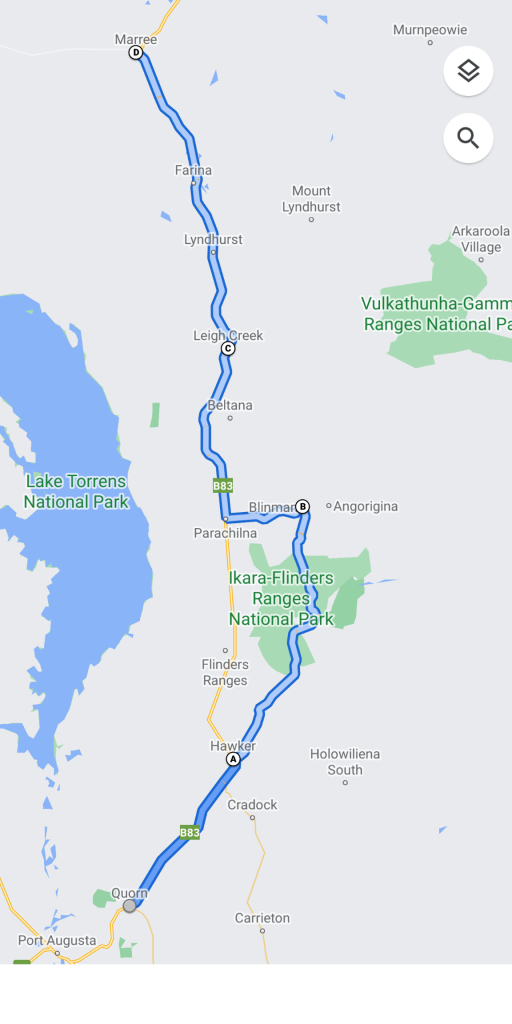
Route 2 (2WD option) | Quorn to Hawker, Hawker to Blinman, Blinman to Parachilna, Parachilna to Marree, Marree back down to Hawker and Quorn | 3 – 7 days
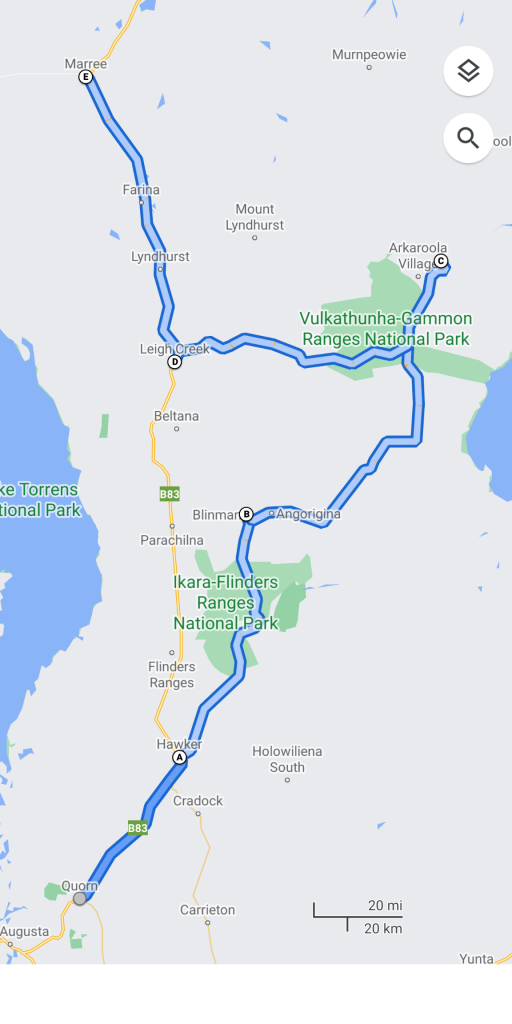
Route 3 (4WD option) | Quorn to Hawker, Hawker to Blinman, Blinman to Arkaroola, Arkaroola to Copley, Copley to Marree, Marree return to Hawker and Quorn | 6 – 14 days
When is the Best Time to Visit the Flinders Ranges?
The Flinders Ranges are hot in summer. Searing, oppressive, soul-destroying, try-to-kill-you hot; not your garden variety hot. The dry, arid, rocky landscape with very few shade trees and fewer swimming areas absorbs and re-radiates the heat as the sun bakes relentlessly. Avoid this time of year if you can.
The best time to visit the Flinders Ranges undoubtedly is the cooler months from May to October. For hikers, the winter months June, July and August are ideal. Winter days in the ranges are cool and sunny, with little chance of rain, perfect for sightseeing.
The nights, however, are cold. It was August when we visited and at night, it was cold enough for jackets, beanies and an extra blanket on the bed.
If your dog will be with you, winter is probably the only time to visit. The cooler temperatures will mean your dog is less likely to suffer heat exhaustion and generally be more comfortable. We also left Chika on three occasions for various lengths of time to do activities that were not dog friendly. There is no way we would or could have left Chika in hot or summer weather.
How Much to Budget for a Flinders Ranges Exploration?
Everyone’s travel or holiday budgets are different. As budget travellers, we found the Flinders Ranges and outback surprisingly affordable with most attractions and activities free. Here is our expenditure (over 12 nights):
- Fuel $479 (including a refill before heading onto the Oodnadatta Track)
- Food (Supermarket) $196
- Caravan Parks $108
- Scenic Flight and National Park Passes $424
- Pub Food, Drinks, Pool and Raffle $79
Total Spent | $1286
Where Can You Buy Fuel in the Flinders Ranges?
Diesel and unleaded fuel are available at the following locations:
- Quorn: Autoport, 24 First St, Quorn and Carlings, 29 First St, Quorn
- Hawker: Mogas, 15 Wilpena Rd, Hawker and BP, 40 Elder Tce, Hawker
- Rawnsley Park Station: Flinders Ranges Road, Hawker
- Wilpena Pound: Perrys, Wilpena Pound Rd, Wilpena Pound
- Angorichina: Angorichina Tourist Village, Parachilna Blinman Rd, Angorichina
- Arkaroola: Arkaroola Road, Arkaroola Village
- Leigh Creek: Perrys, Black Oak Dr, Leigh Creek
- Copley: Mogas, Railway Terrace W, Copley
- Lyndhurst: Perrys 24HR Unmanned, The Outback Hwy, Lyndhurst and IOR Fuel, Strzelecki Track, Lyndhurst
- Marree: Mobil, Railway Terrace N, Marree (Roadhouse)
It is a good idea to have a fuel app as one of your apps for traveling Australia, as it can help you save considerable money on fuel costs. We found fuel in Copley to be 30c cheaper than Marree, a significant saving when filling up dual tanks!
Stock Up Food Supplies
There are limited options for buying groceries, fresh fruit and vegetables or meat. The best option, if you can, is to stock up in Port Augusta or Coober Pedy.
Flinders Ranges supermarkets are at:
- Quorn IGA Supermarket | Seventh St, Quorn
- Wilpena Pound IGA Express| Wilpena Road, Wilpena
- Leigh Creek Foodland | 18 Black Oak Drive, Leigh Creek
And general stores with basic choices and limited supplies are at:
- Hawker General Store and Post Office | Wilpena Road, Hawker
- Rawnsley Park Caravan Park | Flinders Ranges Way, Rawnsley Park Station
- Angorichina Tourist Village | Parachilna Road, Angorichina
- Marree Roadhouse | Oodnadatta Track, Marree
Mobile Phone Reception
Optus has the best coverage across the Flinders Ranges, however where I cannot say so definitively, this is information from locals.
As Telstra phone users, we were able to get reception at:
- Quorn – excellent in town.
- Hawker – good in town.
- Rawnsley Park Station – only using the Telstra hotspot in the camp kitchen. There are plans for Telstra reception to be available across the caravan park from December 2021.
- Wilpena Pound – good in the carpark (the only place we used our phone).
- Blinman – excellent in the town centre.
- Arkaroola – patchy with some periods of working well and other times very slow.
- Copley and Leigh Creek – reception is very scatty and slow outside of the Leigh Creek town centre.
What Wildlife and Birdlife are there in the Ranges?
The dramatic, mostly unpopulated Flinders Ranges boasts an abundance of Australian animals and birds. The must-sees to look out for are:
- Yellow-Footed Rock Wallabies
- Kangaroos
- Euros (like wallabies)
- Whistling Kites
- Mallee Ringneck Parrot
- Elegant Parrot
- Emus
- Wedge Tail Eagles
Travel the Flinders Ranges with your Dog | A Road Trip Itinerary
For this guide I strongly suggest having the WikiCamps App as all caravan parks, free camps and other camping options in this guide are listed on the app and will provide directions.
Our Route
- Quorn: 1 night
- Hawker: 1 night
- Rawnsley Park Station: 2 nights (you could easily add another 1-3 nights)
- Blinman: 2 nights
- Chambers Gorge: 1 night
- Arkaroola: 2 nights (again, you could easily add additional nights here)
- Copley: 2 nights (1 night is likely enough)
- Marree: 1 night (before we did the Oodnadatta Track)
Total distance travelled | 963 kilometres
Quorn to Hawker
Driving distance from Quorn to Hawker | 66 kilometres on a sealed road
Our Flinders Ranges road trip started in Quorn, South Australia. Quorn is a town proud of its history. When we arrived in Quorn for the first, it was as if we had stepped into a bygone era. Once, where the Great Northern Railway (north to south) and the Trans-Railway (east to west) crossed, Quorn was an important buzzing hub on the edge of the Australian outback. The town’s importance only increased during WWII when it became the centre through which over 1 million Australian troops were transported via Quorn to Darwin via the railway.
What to do in Quorn and Where to Camp
The Quorn Heritage Walk was a stroll we enjoyed seeing many of the heritage-listed buildings, including four grand imposing hotels that still stand and operate, to this day. A highlight for us and the main reason for our visit was the Quorn Silo Light Show. The light show projects each evening, just after sunset, the town’s story through local artists and photographers works the local landscape, the fauna and flora. It is a great introduction to the Quorn and the Flinders Ranges and well worth seeing.
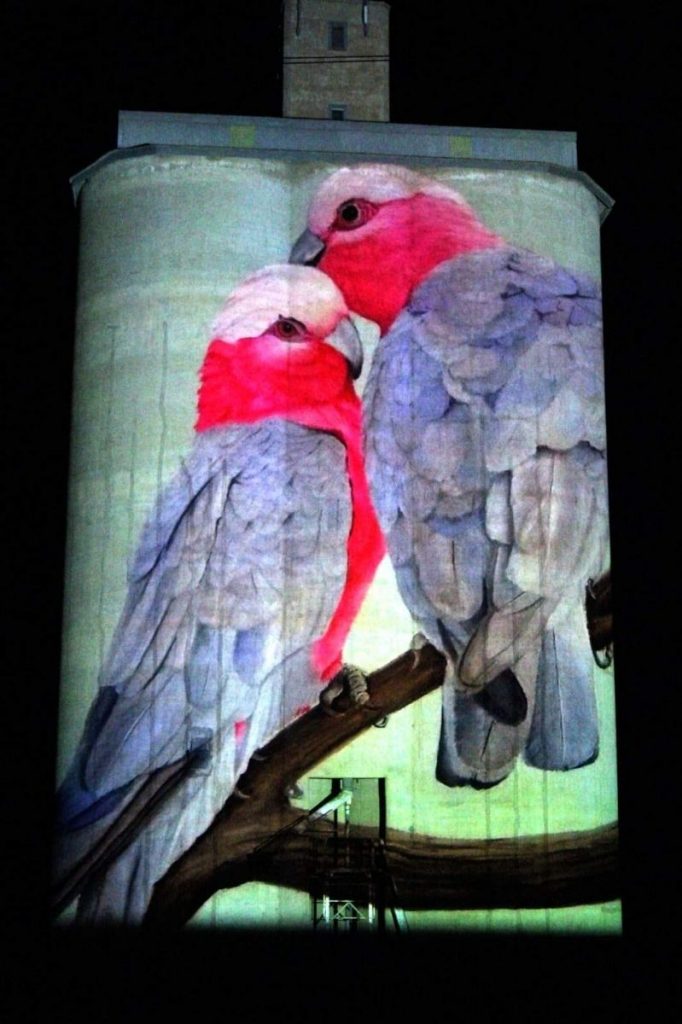
The Pichi Richi Railway is not dog friendly but it would be amiss not to mention this iconic attraction. How often do you possibly get the chance to truly step back in time and enjoy a ride in a restored railcar or carriage pulled along by majestic steam or diesel engine from yesteryear? The heritage railway has been running since 1878 and runs half and full-day return journeys from Quorn on weekends and school holidays from March to November each year.
An easy 21 kilometre drive from Quorn is the Warren Gorge on Arden Vale Road, Yarrah. The Warren Gorge, with its spectacular red cliffs and stunning green cypress trees, is truly something to behold. Take a drive through the gorge better still, do the 5.2 kilometre, easy to moderate walking trail you and your furry friend or perhaps even stay in the campground. Note, the campground is not suitable for caravan and there is a $5 entry fee for non-campers and camping fees.
Quorn Caravan Park, located close to town, prides itself on being peaceful, set among native gardens and a short walk to historic pubs, cafés and local attractions. For the most part, we prefer free or low-cost camps, so we decided to stay at the quiet free camp Pichi Richi a few kilometres south of Quorn. The final option is to camp at Warren Gorge RV and Campground. This campground has long drop toilets, bins and no other facilities. Camp fees are paid at Quorn Information Centre or by self-registration (cash only).
Hawker
Hawker is the town that refers to itself as the “hub of the Flinders Ranges” and probably rightly so, as it is the junction of Flinders Ranges Way, R.M Williams Way and the Outback Highway.
Once a thriving railway town from the 1880s to the mid-1950s until the railway moved further west. Today tourism, sheep and cattle keep the town alive.
What to Do on the Way to Hawker
The Kanyaka Station Ruins, circa 1851, should be your stop on your way from Quorn to Hawker. Once a sheep and cattle property once over 980 square kilometres, today the ruins of the main homestead and other outbuildings can be explored by you. The Kanyaka Ruins are 33 kilometres north of Quorn on Hawker-Stirling North Road.
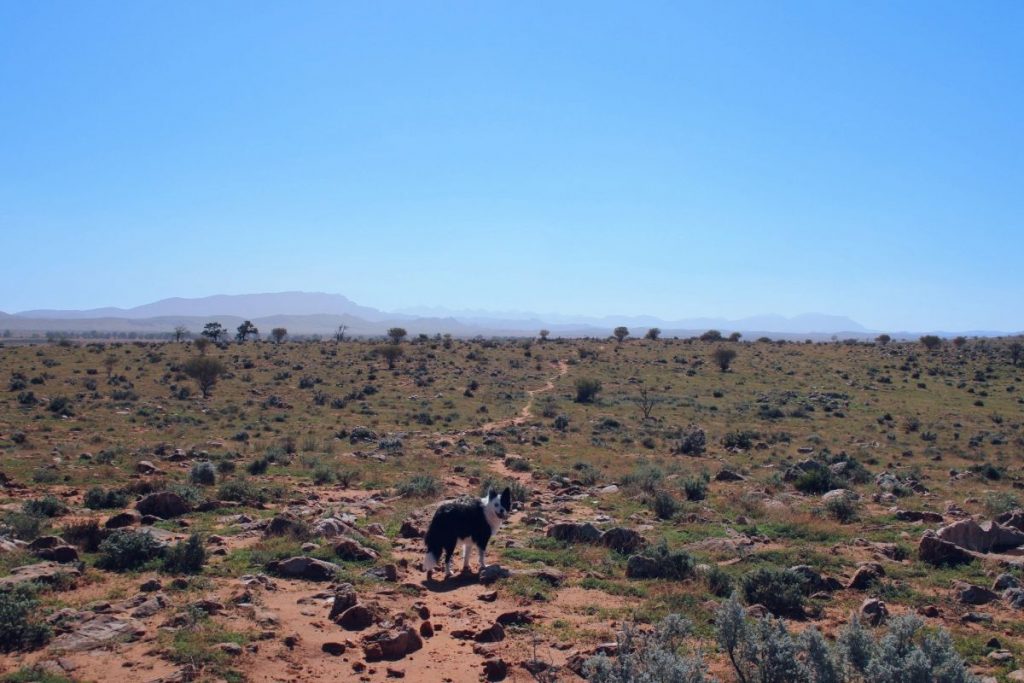
What to See and Do In and From Hawker
The Hawker Information Centre at the Hawker General Store is worth visiting to collect some local information, maps and grab a few supplies you need. Also, on the same street, stop in at the Jeff Morgan Gallery to see the most accurate depictions of the Flinders Ranges in huge panorama paintings and other works you are ever likely to see. There are shaded areas to tether your dog while you are inside.
Castle Rock Lookout is an easy 30-minute stroll to Castle Rock (a large pile of rocks) with views of Hawker. A very exposed track with no trees and over dry, rocky ground, it would not be advisable to do this walk on hot days. In the cooler months, it is a pleasant walk, one which Chika seemed to enjoy. To get to Castle Rock Lookout, drive 1 kilometre down Old Wilpena Pound Road, a dirt road suitable for all vehicles.
Our choice again was to free camp. WikiCamps notes a few free camps 10 – 15 kilometres out of town on the Outback Highway, with Nooltana Creek Rise Rest Area being the closest so, we stayed there for an overnighter. A pull-in stop on top of a hill with fantastic views, the rest area is exposed to the wind, used by trucks and road trains and has no facilities besides a bin. Nooltana Creek Rest Area is another option further along the highway.
Hawker Caravan Park is the in-town option for camping with older clean facilities, the park also has a pool and is an easy walk to the local pub and café.
Hawker to Blinman
Driving distance from Hawker to Blinman: 110 kilometres on sealed road
Continuing your road trip from Hawker heading towards Blinman on the Flinders Ranges Way, the rugged mountain landscape is jaw-dropping amazing and constantly changing. We were extremely lucky to see the landscape after rainfall. The contrast of the red rocks and the green grasses against the background of blue skies was unforgettable.
The scenic drive will take you through the Ikara-Flinders Ranges National Park. If you are traveling with a dog, you are permitted to drive through the park on the condition you do not stop. There is also no requirement to purchase a park pass if you travel through the national park without stopping.
There are several lookouts on the Flinders Ranges Way, all well signposted and dog friendly to stop at, marvel at the views and take photos. Arkaba Hill Lookout, a pull-in just off the road with an unimpeded view of the hills and Elder Ranges. Elder Range Lookout has spectacular vistas of Arkaba Hill and the Elder Ranges when looking out over the highway side.
I highly recommend taking your time on this section of your road trip and stay at either Rawnsley Park Station (this was our choice) or Willow Springs Homestead and Bush Campground. Both, situated on the edge of the national park, are dog friendly and offer activities you can do with your dog. If you stay at one, you can visit the other as a day visitor. I also strongly encourage taking at least part of a whole day to check out the Ikara-Flinders Ranges National Park if your dog can be left alone for any amount of time.
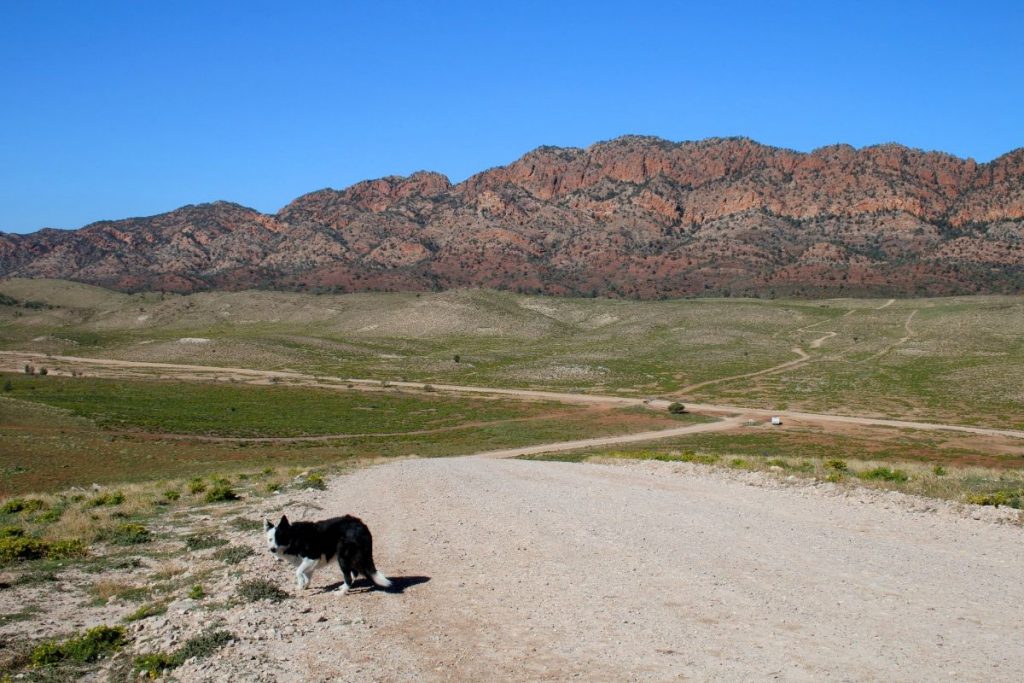
What to Do and See from Rawnsley Park Station or Willow Springs Campground
Rawnsley Park Station
Rawnsley Park Station, overlooked by the southern edge of Wilpena Pound and surrounded by some of the most magical landscapes we witnessed, has fantastic walking trails, lookouts and a self-drive 4WD track you can enjoy with your dog.
The walking tracks up Rawnsley Bluff and others within the station were, we think, almost as good as any in the national park. Varying, from 30 minutes to 5 hours and from easy to moderate difficulty, there is a walking trail to suit everyone. For specific information on each walk, ask the caravan park reception for the walking trails map. Chika thoroughly enjoyed the bush trails, on the cool August days we were there. The markers along each trail let you know how far there was remaining to walk. Psychologically it was very encouraging, for me, especially on the longer trails.
Take in expansive 360 panoramic views from Station Hill Lookout located near the caravan park or Pugilist Hill Lookout via a turn-off on the Flinders Ranges Way and drive 6 kilometres along the dirt road. The dirt road to Pugilist Hill was in excellent condition with no corrugations but a very steep incline to the lookout unsuitable for towing. We unhitched Josephine (our caravan) and drove up; it was worth the effort. Better still, if you are going to camp at Rawnsley Park Station, set up then drive out to Pugilist Hill.
The Arkapena Track is a 4WD self-drive tour that takes in the amazing wilderness of the Chase and ABC Ranges and sights on the neighbouring Arakpena Station. This self-guided tour takes 4-5 hours and there is a fee. Your dog will love the adventure and exploring the sites along the track.
The best way to see some landscapes is from the air. A scenic flight over the Wilpena Pound and the Flinders Ranges is exceptional. The picturesque view from the plane is the only way to truly grasp the beauty, geological diversity and sheer size of the area. We opted to do the 30-minute fixed-winged flight for $200 each from the Rawnsley Park Station airstrip and thoroughly enjoyed our time in the air. And because we did an 8 am flight in winter, we left Chika in our car to sleep right at the airstrip.
Right on the doorstep of the national park, in the Flinders Ranges, Rawnsley Park Station is one of the best dog friendly alternatives to the national park that we found as we traveled the region. The other was Arkaroola Wilderness Resort, which gets a mention later in this post.
Skytrek Willow Springs Campground
Skytrek Willow Springs has an “exhilarating 4WD experience” (to quote their website), the Skytrek 4WD Track. Admittedly we did not do this track ourselves on our trip through the Flinders Ranges, nevertheless some of you will be keen to get into some four-wheel driving and Skytrek is one of Australia’s most famous tracks. The 80 kilometre self-drive track winds through and over rugged mountains and valleys and takes you to visit waterholes, historic sites, Aboriginal etchings and so much more. There is a fee to do this track.
Ikara-Flinders Ranges National Park
Dogs are not allowed in the national park, not even to stay in your car while you explore the park. However, if you can find an option for your dog, I would strongly encourage you to spend some time exploring the national park.
A vehicle pass is required to visit the park and is best purchased online.
Ikara-Flinders Ranges National Park has several walks, the most famous being St Marys Peak, the highest peak on the rim of Wilpena Pound. As dog owners, we try to balance the time we leave Chika and what gives us the best ‘value’ for our time when we visit any national park. We opted not to do the 22-kilometre St Marys Peak track and instead did a 1 hour walk and a 5-hour drive.
One early morning we did the Arkaroo Rock Walk. An easy-moderate (the ground is rocky and uneven) one-hour loop walk (despite the sign saying 2 hrs) with views of Aboriginal rock art. For this walk, we were able to park just outside the national park and leave Chika to sleep in our car in the cool of the morning.
Another day we took a drive along the Bunyeroo Gorge, Brachina Gorge and Geological Trails as this gave us the ability to see a big chunk of the park in the shortest amount of time. It took us 5 hours to do the drive and along the way, we stopped at breathtaking lookouts, drove through stunning gorges and joyfully spotted a Yellow-Footed Rock Wallaby, an absolute highlight. As dog owners, we did the drive in winter, at first light, and returned to camp by lunchtime.
As you continue your way to Blinman, between Rawnsley Park Station and Willow Springs Campground, stop at the Hucks Lookout for views of the northern wall of Wilpena Pound and Stokes Hill Lookout for more views of the ranges.
Thirteen kilometres before reaching Blinman, it is the fascinating geological feature called the Great Wall of China. In a landscape of so many variants and changes, to see yet another unique feature is amazing. A rocky outcrop on the ridgeline, the Great Wall of China is, as you will see, looks like its name’s sake. In the past, walking to the top of the walls was allowed but not longer. It is a pity as the 360 views would be something to behold.
Blinman
Blinman is South Australia’s highest surveyed town. Originally the area was used for sheep farming in the 1850s until copper was discovered in 1859. Throughout the 1860s, the region did well from copper ore and mining. The isolation, drought, low copper prices and high costs of transporting the mineral to the nearest ports meant the mine was closed for good in 1910.
Today, Blinman feels like it is on the verge of becoming a ghost town and is a must-do on your self-drive Flinders Ranges tour.
What to do in Blinman and Where To Camp
Blinman’s main attraction is the Blinman Heritage Mine, an underground tour of the old copper mines. We did not do this tour, seeing Chika had already been left alone on two other occasions so we could visit the national park. I have included Blinman Tourist Heritage Mine because the reviews are outstanding and the chance to explore what was once a working copper mine may be a must-do for you.
While in Blinman, go to the Miner Crib Café Bakery for fresh bread, something like us you may be missing after a few days to a week in the Flinders Ranges. I can vouch for the sourdough bread and from others comments, the coffee is very good too. Then take your pooch for a walk to the Blinman Historical Cemetery and around town to see the Blinman Heritage Listed Buildings and finally make a stop at the North Blinman Hotel for a drink or a meal.
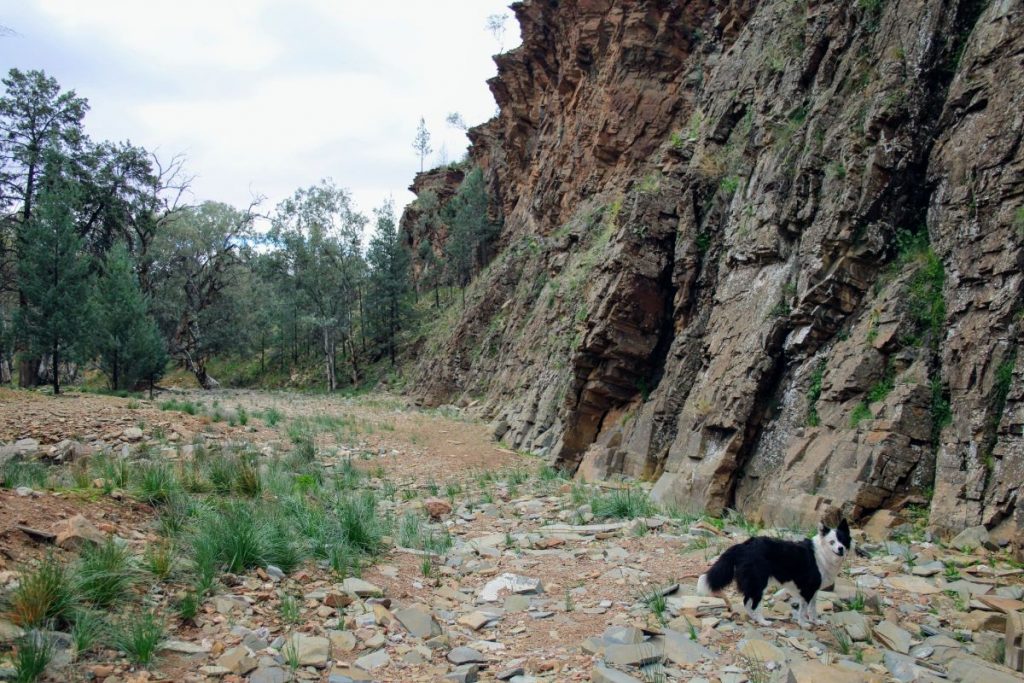
The Glass Gorge and Parachilna Gorge Loop is a gorgeous scenic drive along Glass Gorge and Parachilna Gorge Roads through canyons and ancient forests. There is also the option of doing an offshoot to see the Nuccaleena Mine Ruins, the poor condition of the road turned us off, driving out to the ruins. The loop is about 50 kilometres (2 hours) plus extra to the offshoot to the mine ruins.
When it comes to finding somewhere to camp, we recommend driving the 13 kilometres down the road and stay at the Angorigina Tourist Village. Or better still, check out the free camping at Parachilna Gorge, 19 kilometres from Blinman. Unfortunately for us, we opted to stay at a free camp nearer to Blinman. It was an adequately quiet free camp in a bush setting with no facilities, yet when we drove through the Parachilna Gorge and saw the stunning scenery the campers were enjoying, we were jealous! Of course, we could have moved camp only we had plans to move on to Arkaroola by then.
Blinman to Arkaroola
Driving distance from Blinman to Arkaroola is 155 kilometres on unsealed roads
What to See and Where to Camp on the way to Arkaroola
Indigenous art tens of thousands of years old at Chambers Gorge is well worth the detour on the road to Arkaroola. To see the ancient rock art and carvings drive the 8 kilometres to the end of Chambers Gorge Road and park your car. From there, walk along the dried creek bed (there is no actual track), past the information sign, into the gorge. Initially, you will see a few scattered examples, continue walking for another 5 minutes eventually, you will see a rock wall densely covered in carvings and art.
Free camping is allowed at a few signposted areas along Chambers Road. We stayed one night after having driven 70 kilometres from Blinman to here. There are no facilities at all. The landscape is dry, dusty and desolate, among a few scattered gumtrees and the night sky will take your breath away.
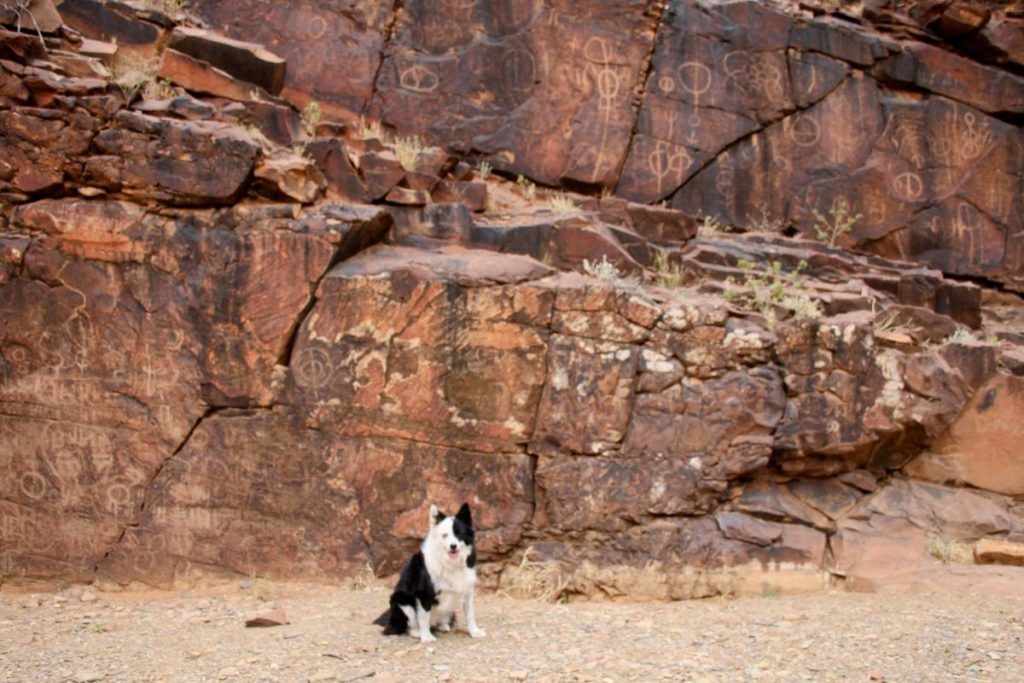
Drive through the Vulkathunha-Gammon National Park landscape on the way to Arkaroola after leaving Chambers Gorge is striking. Again, dogs are permitted to be in your car and you do not need to purchase a pass if you drive through without stopping.
What to Do and Where to Stay in Arkaroola
The only place to camp or stay in Arkaroola is the Arkaroola Wilderness Sanctuary, part of Arkaroola Station. All attractions we recommend are on the Arkaroola Station and are dog friendly except for any paid tours.
Vulkathunha-Gammon National Park is nearby. Other than driving through, on the way to and from Arkaroola, we did not visit the national park. Instead, Arkaroola Station offered so many great options that were dog friendly we did not feel the need to visit the national park.
It is worth noting that Arkaroola Wilderness Resort has strict rules about dogs which are – they must not disturb other guests and they must always be under control. Adhered to these rules and the staff is incredibly accommodating and pet friendly. They allowed Chika onto a courteous bus (we prearranged this) and had no issues with her being in the outdoor areas at the resort.
So, what is there to do at Arkaroola with your dog? The answer, incredible walking trails and self-drive 4WD tracks through the incredibly scenic terrain of the northern Flinders Ranges. The walks and 4WD tracks vary from easy or novice to difficult or experienced (some 4WD tracks have a payable fee).
Guided 4WD tours, astronomy tours and scenic flights are available; of course, your dog cannot tag along. In the peak season tours are very popular so book tours before arriving.
There is so much more to do than we did at Arkaroola. On check-in, staff will give you a comprehensive booklet on everything to do. I recommend taking the time to read this and the website thoroughly and decide what you would like to do with your time.
We opted to do the Bolla Bollana to Nooldoonooldoona Self Drive Track which requires no 4WD experience. The 11.5 kilometre track took us on a journey through the rugged dry landscape of rocky terrain covered in a sparse number of trees (of which only half still seem to be living) and spinifex.
Along the drive, we stopped to see the rock formations of the Pinnacles and the Mawson Valley as well as the Bolla Bollana Springs, the Nooldoonooldoona Waterhole and the heritage Bolla Bollana Smelter Site. It was a fabulous way to spend the morning (about 4 hours). Chika had fun exploring each of the sites except for the mining smelter, which was just inside the national park, so we left her in the car for this one.
Swimming in the springs and waterholes is strictly forbidden. That is because the water is highly relied on by the wildlife and birdlife. People swimming in the waterholes would potentially contaminate the water and deter wildlife and birdlife. Instead, there is a swimming pool open for use back at the resort near reception.
We also opted to do the Acacia Ridge Walk. A 5.2 kilometre walk one way with a lookout with 360* views midway. Arkaroola Wilderness Resort runs a free bus shuttle to the far end of the walk (so you walk the track back to the resort) at 9 am and 1 pm daily. They allowed Chika to hitch a ride on the condition no one else on the bus was afraid or allergic to dogs. Kindly though, everyone on the bus was more than happy for Chika to come along.
The actual walk was brilliant. There are views pretty much the entire way, but the best were are at the lookout. Walking the descent back to the resort on the loose rocky track was challenging. There were a few times my footing slipped and luckily, I managed not to fall. Regardless I still highly recommend this walk. It took us 2 hours but could take as much as 3 – 4 hours. Make sure you wear good walking shoes and take plenty of water.
Arkaroola Station uses 1080 poison meat baits. There is a 2 kilometre exclusion zone around the actual resort, and not put out on the walking or driving tracks. Birds of prey are known to pick up and drop the baits meaning they could be on trails and in the campground. We were cautious with Chika and kept a constant eye on her while not being fearful. Precautions such as using a lead and or a muzzle are ideal.
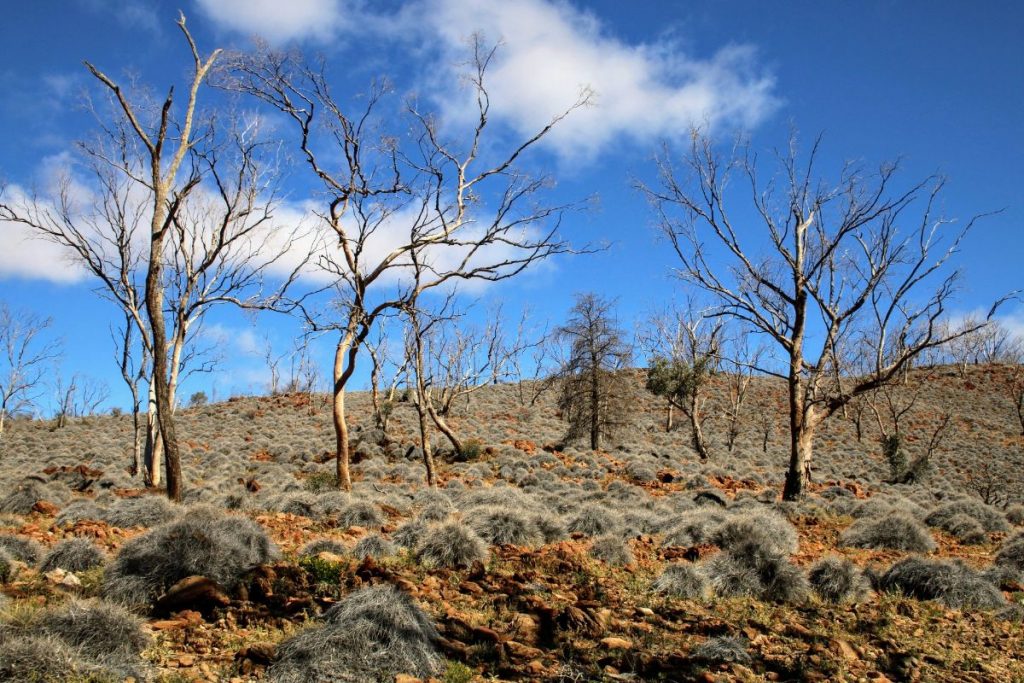
Arkaroola Wilderness Resort is the only option for camping in this area with a dog. Arkaroola Wilderness Park is remote bush camping with the conveniences of powered sites and unpowered bush sites, amenities, a laundry (only $3 a load!), a pool, a restaurant, tours, a service station and more. All sites are dry and dusty, this is the outback after all, but the rocky mountain surroundings and remoteness of this place make it truly special.
A lot of what you would need is available. Well, everything except water.
Water at Arkaroola is highly valued and is available for facilities such as the showers, toilets, laundry and refilling personal water bottles. What you cannot do, is refill your caravan water tanks. We found caravanners with showers and toilets on board were using the park facilities to save the water onboard their caravans.
On the whole, we all entirely cherished our time at Arkaroola. The freedom to see the northern ranges with Chika made the entire experience a relaxing, enjoyable time.
Arkaroola to Copley and Leigh Creek
Distance from Arkaroola to Copley is 129 kilometres
When we did our Flinders Ranges road trip when drove directly from Arkaroola to Copley and Leigh Creek without stopping. A section of this drive goes through the Vulkathunha-Gammon Ranges National Park. Again, a pass is not needed, and you can have your dog in the car if you do not stop.
What to Do and Where to Camp in Copley and Leigh Creek
Copley and Leigh Creek, on what is the start of the true outback, were set up as outback townships to house and support the local mineworkers and their families. That was until 2015, when the open-cut coal mine was closed for good. Since then, the population has plummeted and the towns have been frantically searching for a new purpose.
Today, Leigh Creek provides government and other services to residents of the wider region. There is also a sufficiently stocked Foodland Supermarket, fuel, recreational areas and accommodation for travellers seeking to see the Flinders Ranges and venture into the outback.
We recommend using the air hose at Perrys Fuel Station for reinflating your tyres after returning on the dirt road from Arkaroola. The sign on the air hose says it is for use by fuel customers only. The air hose is very efficient and saves time when pumping up the car and caravan tyres.
Copley is home to a bakery, cafe and the Leigh Creek Hotel. Fuel is also available here.
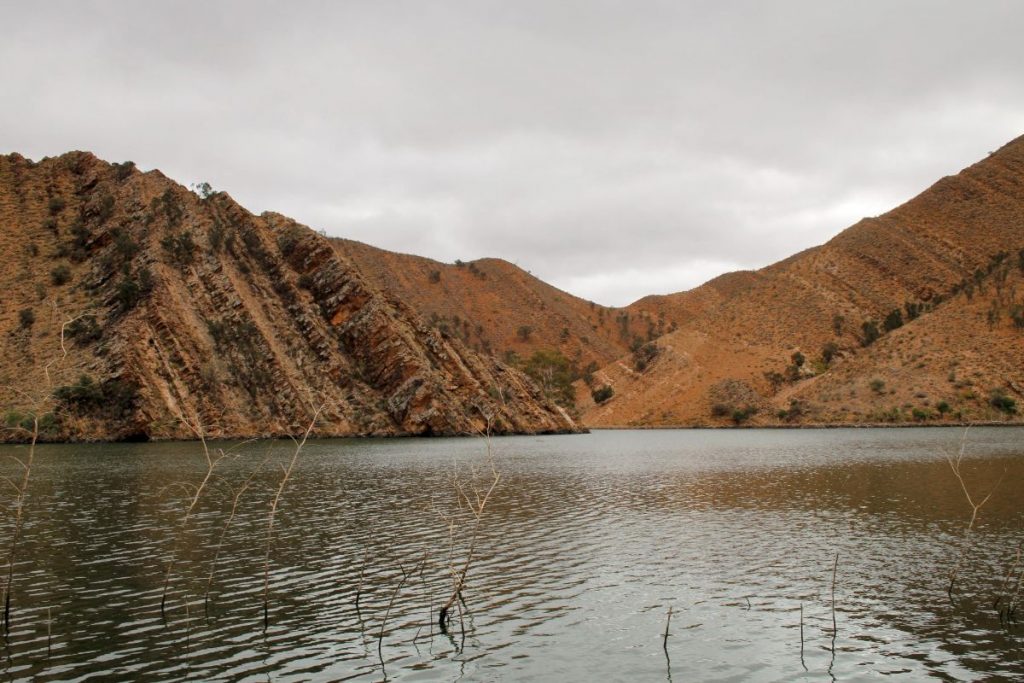
Aroona Dam Sanctuary, 5 kilometres from Leigh Creek, was once the water source for the local coal mine. Since the closure of the mine, the reservoir has undergone significant improvements, with Murray Cod and Golden Perch (yellow belly) stocks added. Today the Aroona Dam Sanctuary is a tranquil oasis in the desert nestled in the hills where you with your dog can enjoy recreational fishing (permit required), paddle on the water in non-motorised watercraft or have a picnic (tables and toilets). There are also two walks, a 5 kilometre interpretative trail and the new 10 kilometre Akurra Trail. The road to the sanctuary is dirt, rough in patches but, accessible to all vehicles.
The Yantruwwanta people are the original custodians of the lands in this area. Culturally important is the Ochre Cliffs up the road 5 kilometres north of Lyndhurst. The Ochre Pits are a quarry used by the Aboriginal people for thousands of years to collect colourful ochre for ceremonial use and trade with other Aboriginal groups. The pallet of vibrant earthy colours is remarkable and a brilliant surprise given where they are.
Copley and Leigh Creek have a few options for camping. The Copley Caravan Park and Leigh Creek Caravan Park both offer powered and unpowered camping sites with amenities. The Leigh Creek Hotel aka Copley Pub in Copley is where we camped and stayed for 2 nights. We cannot praise the publican enough for his hospitality and friendliness during our stay. Sites are limited. Unpowered is free and powered $15 per night (a bargain!) with access to showers, toilets and water. There is no expectation that you will buy any meals or drinks from the pub. We did as well as enjoying a game of pool and Daryl bought tickets in the meat raffle. Sadly (for him) he, did not win.
Copley and Leigh Creek to Marree via Farina
The driving distance from Copley to Marree is 114 kilometres
Farina Historical Village, originally The Gums or Government Gums, was settled in 1878 by farmers and in 1882, the railway came to the town. Once a thriving outback settlement, in the red dust and amongst the saltbush, built from stone and other locally found resources. Farina is now a ghost town.
Today, all that remains is stone ruins, an elevated railway water tank, a historic cemetery and an old Ghan railway bridge and station. Thanks to dedicated and skilled volunteers, many of the ruins have undergone restoration work.
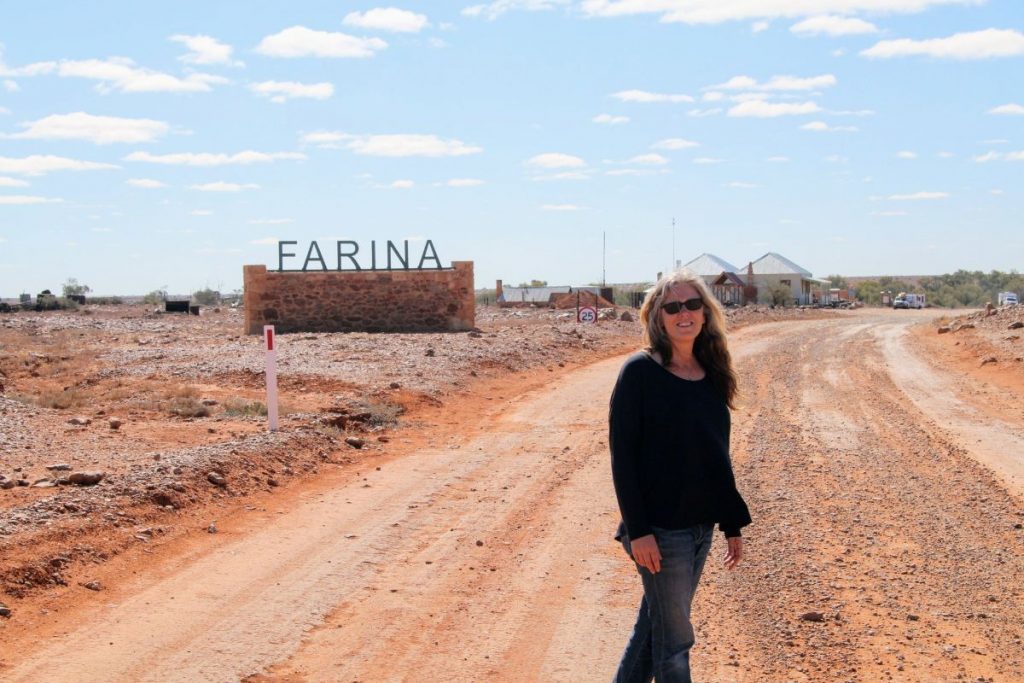
The highlight of the historic town is the original bakery which has been fully restored and operates selling bread and pies for the 8 weeks, late June to early August each year, that the volunteers are completing more restoration work. All the money raised from the bakery goes into paying for the restoration projects. The best time to visit is definitely when the bakery is operating. If it is closed, Farina is still well worth a visit.
The Farina Campground is bush camping at its best, midway between Copley and Marree. Not a free camp, all money from camping fees also going towards Farina’s historic building restorations. There are showers, toilets, bins, shady spots and plenty of room for lots of rigs. During the 8 weeks, the volunteers are in town and the bakery is open, the campground is busy. At other times you can almost have the place to yourself. We did not stay here. After spending half a day checking out the Farina Historic Village, we pushed on to Marree.
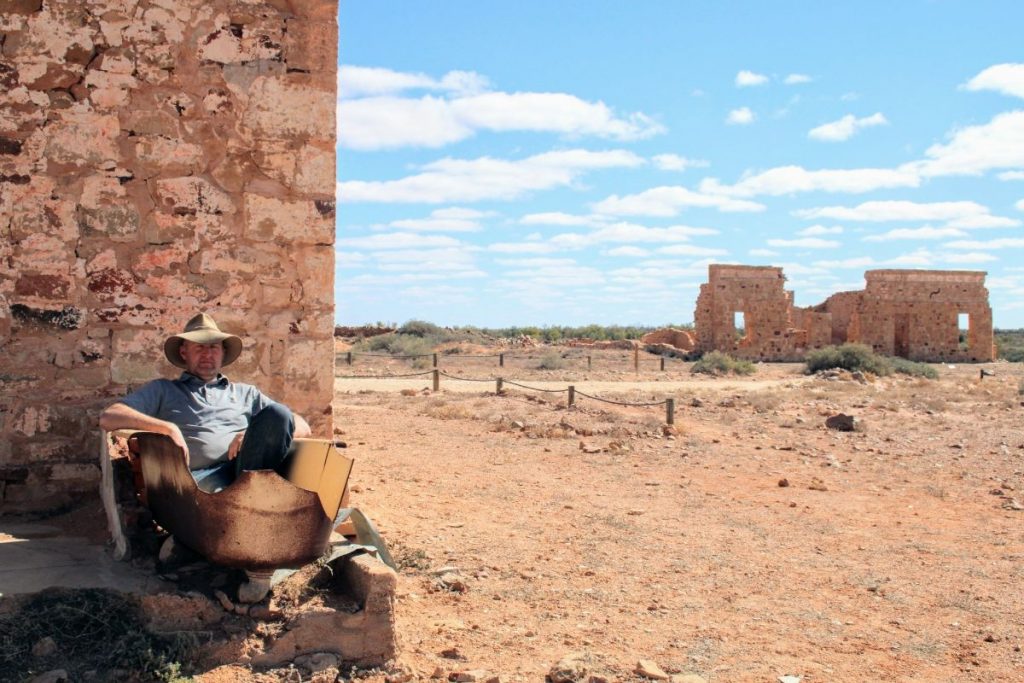
Marree, once a railway town, is about as remote as a town can be and is the end of our Flinders Ranges road trip. On the Barren Gibben Plain surrounded by the Simpson, Sturt’s Stoney and Strzelecki Deserts, Marree is a dry, desolate place and vastly important to the stations and others that somehow make the surrounding region their home.
What to Do and Where to Camp in Marree
Marree is a small remote town with an important railway history on display in the Museum Park. Take a walk with your dog through the park to see the old railway station and platform, old machinery and information boards. Walk by the historic Marree Settlers Cottages and drop into the Marree Hotel built-in 1883 for a drink, a great meal and to have a chat with the locals and fellow travellers.
Maree Hotel has camping. Marree Caravan and Campers Park are also in town.
Interactive Map | Flinders Ranges with Your Dog
Please see our interactive map Dog Friendly Flinders Ranges Road Trip.
Where To Next?
You are now at the end of your epic dog friendly Flinders Ranges road trip. The question is where to next?
From Marree, you could return to Quorn via Hawker along the Outback Highway and make your way to Port August. From there, head down to the Eyre Peninsula, southeast to Adelaide or continue west in the direction of Western Australia including a dog friendly Nullarbor Plain crossing.
If you want to be more adventurous, consider taking one of Australia’s most famous outback tracks from Marree. The Birdsville Track, as the name suggests travels north to Birdsville just over the Queensland border. The Oodnadatta Track heads in a more northwest direction to Marla on the Stuart Highway.
Alternatively, head to Coober Pedy via the Oodnadatta Track and Williams Creek Road and then on to visit Uluru and the Red Centre with your dog.
There is also the option of the Strzelecki Track from Lyndhurst to Innamincka.


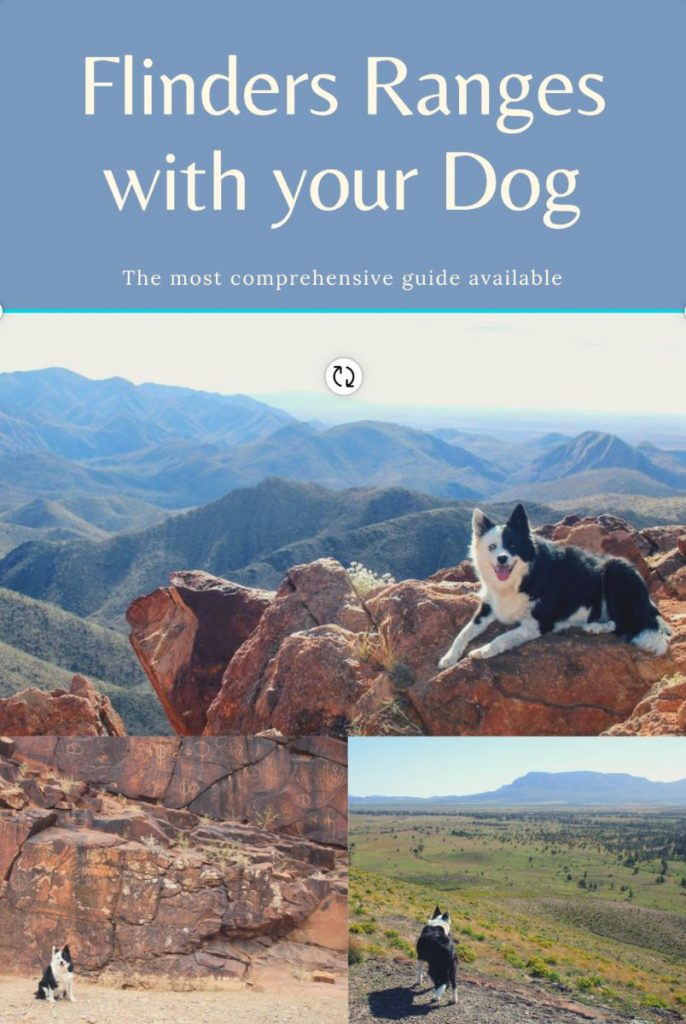
Good Read, very much appreciated, many thanks….
Well presented and well articulated….so hard to find actual out of the way destinations that are dog friendly or acceptable, all State’s NP’s are so anal about dogs, I can understand why in a big picture sense, but there should be a minimum dog obedience standard to allow families with dogs to access NP’s.
Sadly too many irresponsible morons for that to happen, you only have to look at how many dog owners don’t pick up their dogs crap when walking them in the burbs and go from there. I have 2 dogs and will be taking them and yes I always pick up after them.
Can I print off a copy of pet friendly Flinders Rangers
Sorry no it is not printable.
We were so appreciative of your blog on our recent two weeks in the Flinders Ranges with our Kelpie. It was very helpful. An alternative to Rawnsley we found was Mt Little Station, about 20k NW of Hawker with great camping spots, basic facilities but heaps of places to explore and an amazing pizza night once or twice a week depending on the season. Only $15 p/n.
I am super pleased you had a great time with your dog visiting the Flinders Ranges and our blog was helpful.
Mt Little Station sounds wonderful. Thank you for the tip. I will add them to the map as soon as I can.
My sister told me I couldn’t do the Flinders Ranges because I take my dog. Thanks to you I can see I can.
Fantastic effort here guys, extremely informative and helpful, thanks so much for all your efforts!